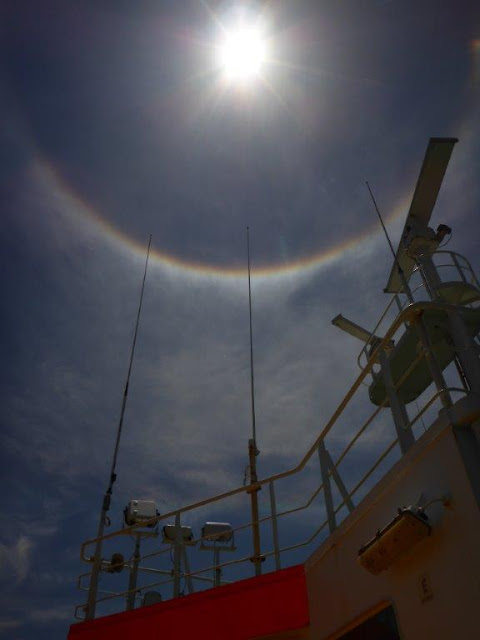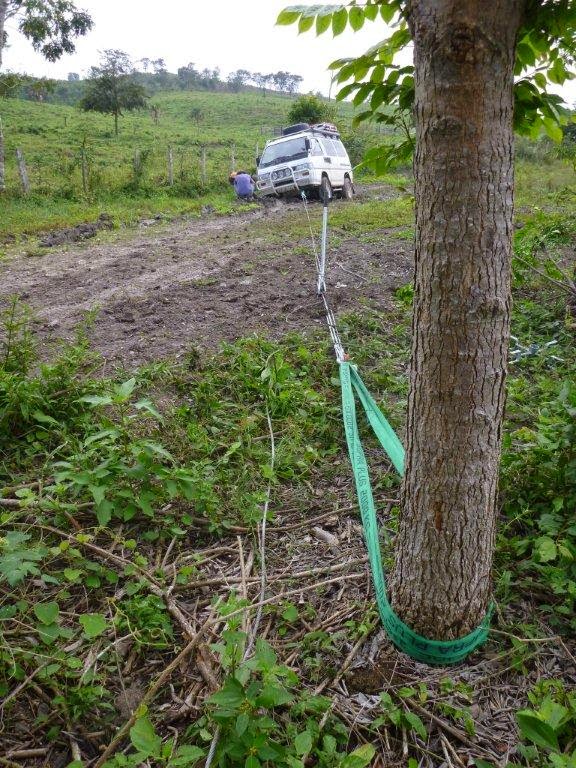I have mentioned it before, I guess. There are hundereds of blogs that list all their fancy shiny stuff they packed up-on leaving for the trip of a life-time but few things you can read about what you really need. What of all those things were usefull, worth spending the money on and more so worth taking the extra weight to take them along. Or what is cheap rubish and broke and what is capable to withstand heavy duty use in dirt, mud and sand or under extensive UV rays on your roof rack.
That is where the Good the Bad and the Ugly of the blue truck was born. I have been travelling for over four years from New York up to Alaska, down to Tierra del Fuego and up again into Brazil. Not always but most of the time on my own, which puts another dimension into the subject of recovery gear. Simply because you are very much what the word really means, alone. Meaning, no one to push, no one to pull. Just you, yourself and your gear. Get out of the car into the mud, get prepared for everything, put weight on your come-along steel rope, get into the car and try to free it up, and all over again, that kind of thing.
Here is most of the stuff I took in terms of recovery gear, (common things a shovel and emergency repair stuff like duct-tape and so on are not listed):
- Two steel rope tree slings
- 30 meters of steel rope for the Habegger manual winch (come-along)
- The Habegger come-along itself
- A pulley for the Habegger
- Several towing-belts
- Two endless tree sling-belts (the green ones)
- Crow-bar
- Saw
- Machete
- Hi-Lift with base and some additional stuff
- Several shakels
I also took four sand-boards, two 1.20 meter long ones (on the roof) and two 1.40 meter long ones attached in a mount on the side of the Toyota. I started off with two and was given an other two by fellow travellers
Kari and Ulla when we've met in San Miguel de Allende, Mexico. There are several different type of boards that you can find on the market or build yourself. Important is that they are strong enough for the weight of your vehicle and light enough to handle and carry around. Remember you will need to be able to handle them when they have lots of mud and dirt sticking on them, that can quickly double the weight. Longer boards are much better to get out but much more difficult to handle and store. The also tend to bend quicker.
Like most of my recovery gear I have used it more often to help others than to get myself out of trouble. And that is quite o.k. that way. Here are some pictures of the gear in action.
Towing belts in action, pulling out Toni and Felix' "Dino" out of a mud hole in Guatemala. Just a comment: Rainy season had not begun yet.
I bought the Hi-Lift in the USA, since the units are perversely expensive in Europe. While in Texas camping on a state park I built a mount for it on the standard Toyota front bumper. Not as nice as I wished it to be but for a road job ok and functional. The Hi-Lift weighs over 20 some kilos, I wanted to have it as low as possible not to further encrease the center of gravity to a higher point and as much in front as possible to get weight distributed better but at the same time still high enough not to get damaged when hitting small trees and alike.
As you have heard before. The Hi-Lift is not a jack. It is a tool: Another way to put the Hi-Lift to work. Fixing a dent in the rear bumper by applying the cars weight on the bent bumper and...
This is how the finished job looked. Still pissed me off that I had hit a tree, not while off-roading or so, simply by reversing on a free-camping spot.
In early spring on a BC forest road I have managed to sink axle deep into a very small mud hole under the snow. Just a little more speed and I would have flown over it. But I didn't. After trying to get myself out with diff locks, low gears and all, I have first lifted the Toyota with the Hi-Lift, built a base in the soft sludge and mud with wood set it down on the board and...
...pulled myself out with the come-along (Habegger). The chassis with the main weight set on the snow, not on the wheels anymore. This looks all like a minor situation but when you are alone it involves a lot of work to get yourself out of some silly situation like that.
The sand board monted on the side double as a kitchen table, or call it my bar. A beer can perfectly fits into the holes.
I always kept the mechanical portion of the Hi-Lift covered, in order to protect it from dirt. I removed cleaned and oiled it about every two month (if I haven't used it earlier on)
It looks bad, but worse for all your equipment and for your car is sand. I must also say, that the Hi-Lift is build very wel and beautifully simple. The mechanical part is simple with high tolerances that make it difficult to seizure at all. It likes oil a lot better than grease.
Also a part of my recovery equipment is a pair of tall rubber boots. Because when you are in deep shit...
...it is you who has to go out there and dig in it. And while my outdoor sandals are great, I still don't really like to get into that kind of envirnoment in'em.
This kind of products might help you to get into the hole, but they will not help you out of it! So, don't count on it for recovery!
We used about every thing we had to get the "Dino" out of the mud again in Guatemala...
Habegger come-along with pulley and tree belt set up. A big advantage of the come-along is that you can use and attach it about every where, front, rear, side and so on. Still you do need some place to attach it too. In sand you might burry your spare wheel deep into the sand and use it as an anker. I have not had to do that yet but heard from others that it'll work. And here...
the whole thing in action...
They're called sand boards but they work just as well in mud. They have too. I actually used them more often in mud than sand.
They work: Some how and...
...some times anyways.
Some of the wild life likes 'em as much as I do.
I was lucky. On this trip to a hidden Maya ruin in Mexico's jungle I was not alone. I teamed up again with Felix and Toni and we hired a Mayan guide who was leading us to some beautiful ruins hidden in the green.
First I got stuck, than Felix got stuck. Than we got both out of it again. We had to get through here again on the return way. Being aware of it we took the same section with lots more speed and got through.
Cleaning the gear next day, after a long day in the jungle. Think about some spot, a large bag or something where you can through all the dirty stuff in at the end of the recovery process, otherwise you'll have it all in your "living room". Recovery adventures can make you very tired and last into the night, so at the end you'll probably won't have the energy to clean and store everything properly prior to finding a camp for the nighht.
Small trees like that you can pull off manually with your hands. Or just drive over them. Larger ones I have pulled off the streets just with the Toyota and a twoing belt. In Central America though I had to take out axt and saw a couple of times to get through.
When you venture out to beautiful deserted places like that as a solo traveller you wanna make sure to be able to depend on your gear and to be able to handle it on your own. More important than anything here is low tire pressure.
You also want to have sufficient food and water with you, as well as a good set of tools and repair material, but we'll get to that in one of the coming GBU posts.
Conclusion:
What broke:
- I broke one 5 ton towing belt. Not really by weight, I have attached it around the bumper to pull out a Land Cruiser from mud in Colombia, we had to put as much force on it, realease and pull again until the heat melted some of the woven net and it was not longer safe to use after that.
What would I leave at home:
- The Hi-Lift is a geat tool and being a technic freak I love it. Is it really necessary and worth the extra weight? Probably not. I do not think I really depended on it. As a jack it is a dagerous thing. I have two standard bottle jacks that I took a long, the original Toyota standard mechanical jack and a hydraulic jack like you can buy anywhere. So I think that is something I couuld have done without.
What I would not leave without:
- The Habegger come-along. I have used it few times. But I found it much more versatile than a winch at the front bumper. It is exttremly high quality, heavy duty built. If you are solo travelling and are planning not to stick to the main roads, this might make the difference to get you out.
- Several shakels and several towing belts, tree slings and so on. This will allow you to come up with some kind of a solution to most of your challenges
- Saw, machete, axed and crow bar are not just useful for recovery they are also essential tools when free camping.
Feel free to add a comment if you think I have forgotten something, have missed a point or just with any kind of comment. Looking forward to your feedback.
When you are alone, you are alone. Be prepared and enjoy the beauty of the solitude.










































































